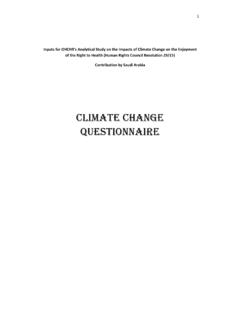Transcription of Deforestation and Climate Change - Climate Institute
1 Deforestation and Climate Change Lauren Bennett April 2017 1 The Climate Institute | Deforestation and Climate Change Forests play many important ecological roles. From helping to mitigate Climate Change ; providing homes for many species of plants and animals (some endemic to forested regions); providing food, medicine and livelihoods for people around the globe; to the intrinsic values of forests, these essential ecological powerhouses are irreplaceable and at risk. Forests cover 31% of our planet;1 the Amazon rainforest alone is home to hundreds of thousands of species of plants and Yet, despite everything forests do for the planet, they are being cut down at an alarming rate.
2 Every year 46-58 thousand square miles of forest are lost to Deforestation , which is equal to an astounding 48 football fields of forest disappearing every Although there is much cause for concern when considering the degradation of forests worldwide, many still have hope that with the right changes in policy and perception, forests can still be saved. Why are we cutting down forests? There are many factors that contribute to Deforestation , each with its own causes and negative environmental impacts. Table 1: Summary of Main Pressure of Forests in Different Deforestation Fronts Source: Mongabay News. Deforestation Fronts Revealed 2 The Climate Institute | Deforestation and Climate Change Agriculture Agriculture is one of the most significant causes of Deforestation .
3 The first form of agriculture that will be examined is slash-and-burn agriculture. Slash-and burn agriculture can be a sound agricultural practice in many instances, and has long been practiced by many aboriginal communities. Although the jury is still out on how sustainable this practice is, many believe that small scale practice of slash and burn, or swidden, as practiced by some aboriginal communities, can actually be beneficial to the soil and biodiversity. Slash-and-burn: Slash-and-burn agriculture is responsible for the loss of around 50 acres of land every hour One of the issues with slash and burn is that fires intentionally set can unintentionally spread throughout the When fire spreads to unintended areas, the protective forest canopy is destroyed.
4 The resulting sun exposure to the forest floor intensifies the existing The smoke then hangs over the forest, and suppresses rainfall, 7 making it even more difficult to extinguish as the area becomes drier. For example, in the Amazon rainforest the seasons are so extreme, in terms of precipitation, that there are just two named seasons: wet and dry. During the dry season, the problems with slash-and-burn agriculture are intensified. Although there are many, complex issues surrounding the use of slash-and-burn agriculture in the Amazon, the underlying rationale for the practice is very simple: the soil in the Amazon rainforest is infertile,8 much to the dismay of the estimated 250 million farmers working the poor soil of the tropical forests For impoverished farmers, the simplest solution to this problem is to cut down the trees, and burn what remains.
5 This makes the soil more fertile10 as incinerated biomass provides nitrogen and other nourishing nutrients for the soil. 3 The Climate Institute | Deforestation and Climate Change Unfortunately, this is a short term solution. The soil only stays nutrient rich for so long, about two years11, after this time, the nutrients from the burned biomass are used up. When this happens, farmers pack up and move on to the next section of the rainforest, leaving their farmland behind for others to use for cattle rearing, or Furthermore, slash-and-burn agriculture on this scale can also have devastating affects for the biodiversity in the area. With large areas of land being incinerated, many animal habitats are lost in the fire.
6 This pushes animals out of the forest, decreasing biodiversity, and increasing the number of endangered and extinct animal Climate Change impacts Although in some instances it can be advantageous, burning biomass on such a large scale comes with many consequences. It is estimated that the total amount of biomass burned by humans make up a whopping 90% of the total number, where natural fires are only around 10%.14 According to NASA, Since fires produce carbon dioxide, a major greenhouse gas, biomass burning emissions significantly influence the Earth's atmosphere and Climate . Biomass burning has both short- and long-term impacts on the environment. Vegetation acts as a sink a natural storage area for carbon dioxide by storing it over time through the process of photosynthesis.
7 As burning occurs, it can release hundreds of years worth of stored carbon dioxide into the atmosphere in a matter of hours. Burning also will permanently destroy an important sink for carbon dioxide if the vegetation is not replaced. 15 In addition to its local effects, burning organic materials on a large scale, like what is done with slash-and-burn agriculture, emits greenhouse gases, which contribute to global Climate Change . Raising Cattle 4 The Climate Institute | Deforestation and Climate Change Cattle ranching has a massive impact on forests around the world, particularly tropical rainforests like the Amazon. Many farmers use deforested areas of land to raise cattle; however, it might surprise you to learn that corporations do this on a much larger scale.
8 Fast food companies have been contributing to Deforestation in places like the Amazon rainforest for quite some time, and only in relatively recent years have their actions been acknowledged by mainstream media. Companies that have been deforesting the rainforest in order to raise cattle for their hamburgers include: Wal-mart, McDonalds, Pizza Hut, and Burger King, just to name a few. Although some of these companies have made promises to be more environmentally conscious, some, such as Burger King and Pizza Hut, have made no plans to move away from this harmful and unnecessary form of animal Figure 1. Source: Mongabay. Amazon destruction 5 The Climate Institute | Deforestation and Climate Change Logging Logging is also a common cause of Deforestation as trees are cut down to use for paper products.
9 There are several different types of logging: however, the most harmful one is called clear cutting. This is when an area of forest is completely deforested, leaving no trees alive in that area. In some cases, areas of forest that have been clear cut are candidates for remediation. Remediation of clear cut areas of forest, however, comes with its own issues. Often times mono-planting is a go-to remediation plan, which is to say that only one species of tree is planted in that area. Although this does help to remediate the complete loss of trees, it doesn t remediate much else. All of the biodiversity lost to clear cutting is not remedied by mono-planting. This is because biodiversity is supported by a diversity of flora as well as fauna.
10 By simply planting 1,000 oak trees in an area which previously was home to many species of trees, the environment now only supports those animals that find food or shelter from oak trees alone. Mono-cropping is therefore not a sustainable solution to clear cut land. Climate Change It is estimated that 25% of the world s total greenhouse gas production comes from Deforestation Furthermore, forests around the world store more than double the amount of carbon cioxide than is found in the atmosphere18 This means that when areas are deforested, the carbon dioxide stored in those trees is released into the atmosphere. Logging for paper products is one of the simplest causes of Deforestation to solve.



